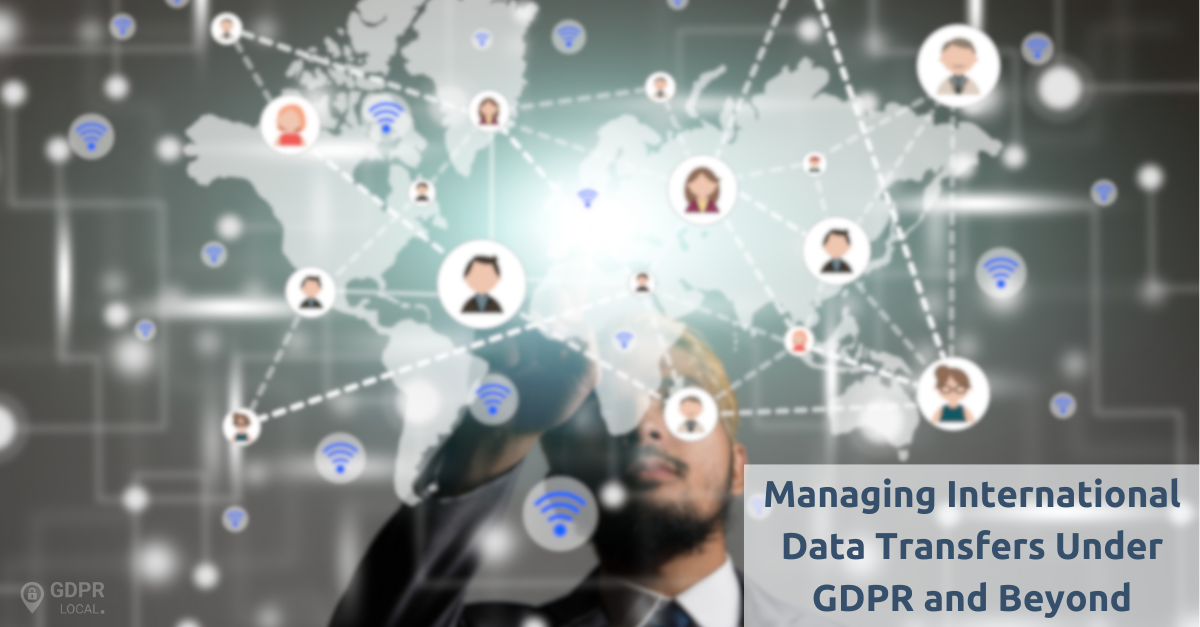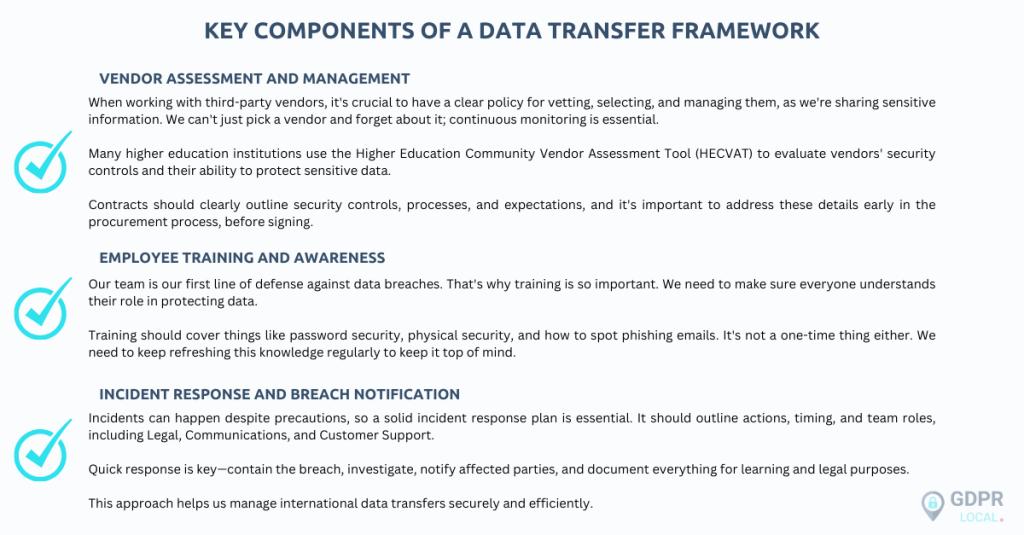
Managing International Data Transfers Under GDPR and Beyond
We live in a world where international data transfer has become a crucial part of how businesses operate. As companies expand globally, they need to move personal data across borders, but this comes with its own set of challenges. Data protection authorities worldwide have set up rules to safeguard personal information, making it essential for organizations to understand and follow these regulations.
In this article, we’ll explore the ins and outs of international data transfers. We’ll look at how the rules have changed over time, what key things to keep in mind when moving data across countries, and the specific challenges different industries face. We’ll also discuss how to build a strong framework for data transfers and wrap up with some final thoughts.
Here’s everything you need to know about data protection, whether you’re a data protection officer or just interested in the topic.
The Evolution of Data Transfer Regulations
We’ve seen quite a journey in the world of data protection over the years. It’s been a rollercoaster ride, with regulations changing and evolving to keep up with our increasingly connected world. Let’s take a closer look at how things have shifted.
From Safe Harbor to Privacy Shield
Back in 1998, the EU introduced the Data Protection Directive. This was a big deal because it required member states to set up laws to protect personal data. The directive was pretty strict about how data could be used, saying it had to be “collected for specified, explicit and legitimate purposes”.
Now, this created a bit of a problem for data transfers between the EU and countries like the US. To solve this, the US Department of Commerce and the EU came up with the Safe Harbor agreement. This let US companies self-certify that they were following EU data protection principles.
But here’s where it gets interesting. In 2015, an Austrian law student named Max Schrems challenged Facebook’s data practices in court. This led to a bombshell decision by the European Court of Justice (ECJ) that invalidated the Safe Harbor agreement. Just like that, companies couldn’t rely on Safe Harbor anymore for their data transfers.
This wasn’t the end of the story, though. In July 2016, the EU and US introduced Privacy Shield as a replacement for Safe Harbor. It was meant to address the concerns raised by the ECJ and keep data flowing between the two regions.
GDPR’s Global Impact
Then came the big one – the General Data Protection Regulation (GDPR). This regulation, which came into effect in 2018, has had a massive impact worldwide. It introduced some game-changing principles:
1. Data Protection Authorities (DPAs) can now make binding decisions and issue fines.
2. People have the right to object to certain types of data processing.
3. Organizations must notify authorities and individuals about data breaches.
4. There are stronger requirements for consent.
5. Biometric and genetic data are now considered sensitive.
6. Many organizations now need to appoint Data Protection Officers (DPOs).
The GDPR has influenced data protection laws far beyond Europe. We’ve seen a “GDPR domino effect,” with countries around the world implementing similar frameworks . This has had a significant impact on businesses, especially those operating internationally.
Emerging Data Protection Laws Worldwide
The ripple effect of the GDPR has been truly global. Let’s look at some examples:
| Brazil | The Lei Geral de Proteção de Dados (LGPD) came into effect in 2020. It’s very similar to the GDPR and applies to all data subjects in Brazil. |
| China | In 2021, China enacted its Personal Information Protection Law (PIPL). |
| Thailand | The country introduced its first consolidated Personal Data Protection Law (PDPA). |
| Japan | The Act on Protection of Personal Information (APPI) regulates personal |
| Canada | The Personal Information Protection and Electronic Documents Act (PIPEDA) governs data protection at the federal level. |
As of now, 120 countries around the globe have established privacy and security regulations. This shows just how important data protection has become on a global scale.
We’re seeing a trend towards more comprehensive and stricter data protection laws worldwide. These laws often take inspiration from the GDPR but also reflect local concerns and legal traditions. It’s clear that data protection is no longer just a European concern – it’s a global priority.
Key Considerations for International Data Transfers
When we’re dealing with international data transfers, there are several key things we need to keep in mind. Let’s dive into some of the most important considerations.
Data minimization and purpose limitation
We always need to remember the principle of data minimization. This means we should only collect personal data that’s directly relevant and necessary for a specific purpose. We shouldn’t be gathering more information than we need, and we should only keep it for as long as it’s necessary.
The GDPR is pretty clear about this. It states that personal data must be “adequate, relevant and limited to what is necessary in relation to the purposes for which they are processed” . This isn’t just a suggestion – it’s a requirement.
We also need to think about purpose limitation. This means we should only collect personal data for specific, explicit, and legitimate purposes. We can’t just gather data for one reason and then use it for something completely different later on.
Special categories of personal data
Now, let’s talk about special categories of personal data. These are types of information that are considered particularly sensitive. The GDPR prohibits processing data that reveals: racial or ethnic origin, political opinions, religious or philosophical beliefs, trade union membership, genetic data, biometric data for identifying a person, health data, data about a person’s sex life or sexual orientation.
However, there are some exceptions to this rule. For example, if the data subject has given explicit consent for a specific purpose, or if the processing is necessary to protect someone’s vital interests, then it might be allowed.
Data subject rights in cross-border contexts
When we’re transferring data internationally, we need to make sure we’re respecting the rights of the individuals whose data we’re handling. Under the GDPR, people have several important rights:
1. The right to have incorrect or incomplete data rectified
2. The right to object to the processing of their personal data
3. The right to be informed about how their data is being used
If someone asks us to correct their data, we need to do it without undue delay. And if we’ve shared that incorrect data with anyone else, we might need to let them know about the correction too.
It’s also worth noting that people can object to their data being processed at any time if we’re doing it based on our legitimate interests or for a public task. Unless we have a really strong reason to continue, we need to stop processing their data if they object.
Ensuring adequate protection
When we’re transferring personal data outside the EU, we need to make sure that the protection offered by the GDPR travels with the data. This means we have to ensure one of the following:
1. The non-EU country has protections that the EU deems adequate
2. We take necessary measures to provide appropriate safeguards, like including specific clauses in our contract with the non-EU data importer
3. We rely on specific grounds for the transfer, such as getting the individual’s consent
By keeping these considerations in mind, we can manage the international data transfers more effectively and ensure we’re complying with data protection regulations.
Building a Solid Data Transfer Framework
We’ve learned that building a solid framework for data transfers is crucial. Let’s dive into the key components that make it work.

Conclusion
International data transfers present complex challenges for organizations across various sectors. From multinational corporations to academic institutions and law enforcement agencies, each faces unique hurdles in managing cross-border data flows. The evolving landscape of data protection regulations, including GDPR and its global counterparts, has a significant impact on how data is handled and shared internationally.
Organizations need to build robust data transfer frameworks. This involves careful vendor assessment and management, comprehensive employee training, and well-prepared incident response plans. By focusing on these key areas and staying up-to-date with changing regulations, businesses can better protect personal data and maintain compliance in their international operations. The goal is to strike a balance between data protection and the need for cross-border data sharing to support innovation and growth.
For more information or support regarding international data transfers, reach out to our team at [email protected].
FAQs
What does an international data transfer mean under GDPR?
An international data transfer under GDPR is the process of transferring personal data from one country to another.
Is it permissible to transfer data outside the EU under GDPR?
Yes, but such transfers must comply with specific conditions outlined in Chapter V of the GDPR. These conditions must be adhered to alongside the general rules of GDPR compliance.
Is it possible to transfer data to the US under GDPR?
Yes, data can be transferred from the EU or UK to the US under GDPR. There is no complete prohibition on such transfers. However, certain types of data processing, like analytics, may require consent if the data will be accessible from the US.
What types of data transfers usually require a specific mechanism under GDPR?
Under GDPR, data transfers that fall under Articles 44-50 typically need one of the four established mechanisms to be considered legitimate. These include Adequacy Decisions, Standard Contractual Clauses, and Binding Corporate Rules. Additionally, there are certain exceptions or derogations that can apply.